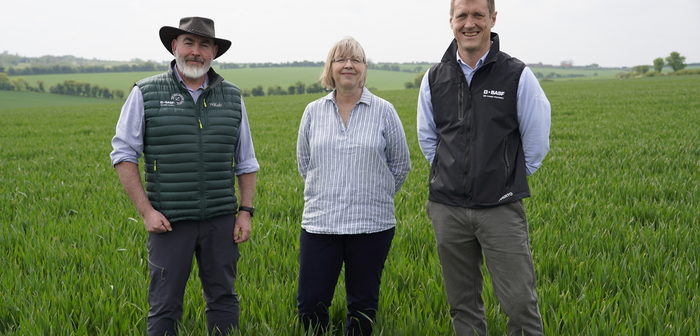Recent rain has given stressed winter wheat crops a fighting chance of fulfilling their potential; however, careful management will be needed to ensure this rain does not allow disease ingress onto the main yield building leaves. BASF agronomy managers have been assessing the state of play in crops up and down the UK.
In the south Andrew Clune said, “Everything is coming along nicely, the crops look really well. There has been some rain over the last three weeks and most growers have had a reasonable amount now. It’s dry but the soils are moist and yield potential hasn’t been affected by it.
The T1 sprays are on with the majority of growers using an SDHI at T1, which will have been well worth it as we have had some rain on top of it. Things are very clean, however Septoriais easy to find but Yellow rust doesn’t seem to be an issue at the moment.”
Further up the country, in the Cotswolds, Jon Helliwell said, “The weather has generally been quite dry with some very welcome intermittent showers; this has meant that some of the crops that were starting to show drought stress are now looking quite well.
T1s have been applied in good time, so where rates were sensibile leaves 3 and 4 will be protected; however, there is a risk that where T1s were scaled back or in some cases not applied at all, there is the potential for disease ingress. If T1s went on early, current crop growth has slowed on later drilled blocks or T2 applications look like they may be stretched, a T1.5 holding application may be needed to protect leaf 2. The timing of T2 should not be compromised.
Septoria is still on the lowest leaves at the moment, on leaf 5 and on the very tip of leaf 4. There is a concern that that where leaves 2 and the flag are emerging, they are in very close proximity to active lesions on leaf 4. It only takes overnight dew or rain on that tip to transfer inoculum onto the currently unprotected upper leaves, the main yield building ‘solar panels‘.”
The last 2 years have seen bad late brown rust in the Cotswolds, particularly if conditions remain dry and warm later in the season. Mr Helliwell said, “Images of lost green leaf area late in the season due to brown rust over the last few years may be fresh in growers’ minds. Adexar® is a great start to late season brown rust control at T2, and there remain strong options at T3 to follow up if required. The main threat and the focus at T2 has to be on Septoria, the biggest yield robber.”
Across in the east a little rain has at last fallen and there is still potential in wheat crops. Matt Keane said, “The recent dry conditions have meant the crop has rather raced through its growth stages, when plants are faced with dry conditions; they just try to flower as fast as possible.”
Giving the preceding dry Mr Keane reports levels of Septoria in untreated plots are fairly normal. He said, “Where they have had T0 and T1 there is less but there is still Septoriain the bottom of the crops. I would be a little bit worried if I hadn’t put on a robust T1.
We have done research which measured non visible (presymptomatic) infection, by analysing the leaf DNA, of the top 4 leaves just before T2 and found more than 50% of leaf 2 and the flag leaf were infected as well as over 75% of leaves 3 and 4.”
T2 in Suffolk is around the 20thof May, however, some for some early drilled September crops it will be sooner. Mr Keane said, “A well timed T2 is the biggest benefit to yield. You want to keep the flag leaf green for as long as possible if the weather conditions are right then you can get big yields. 1.25l/ha of Adexar®or Librax®with chlorothalonil has worked really well in the past two seasons; both are very good on Septoria and rusts.”
In Yorkshire Mathew Barnes reports that recent rains have given stressed crops a fighting chance of fulfilling their potential. However, susceptible varieties are starting to show Septoriaon leaf 5 especially where there have been heavy dews. He said, “This has now turned a perceived low disease year to a higher potential as Septoria inoculum will rain splash up the plant especially on those shorter stressed crops.”
In Scotland Scott Milne said, “Thereis not a huge amount of disease about at the moment and the wheat is motoring along nicely, it looks well and everybody has been timely with their sprays to date.”




